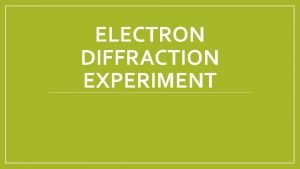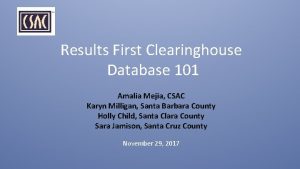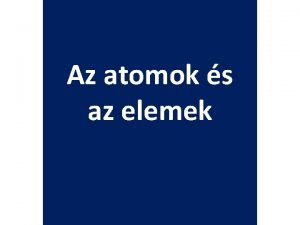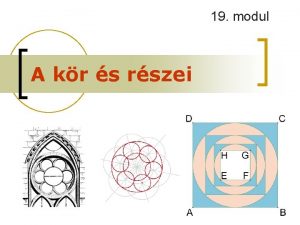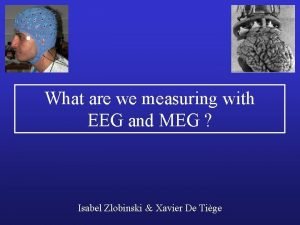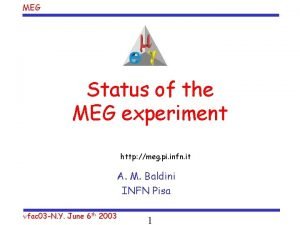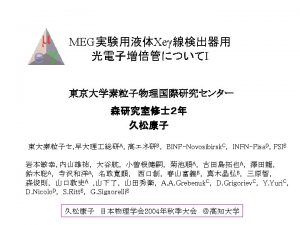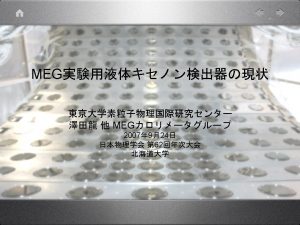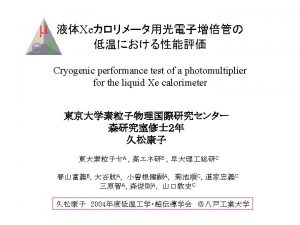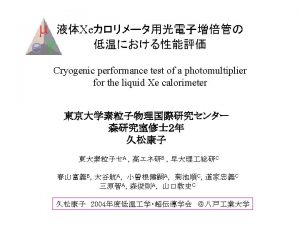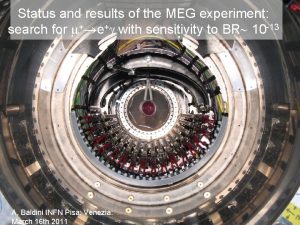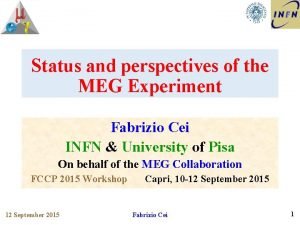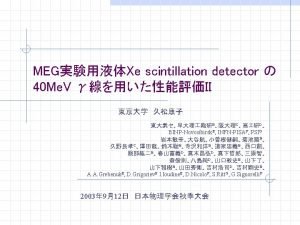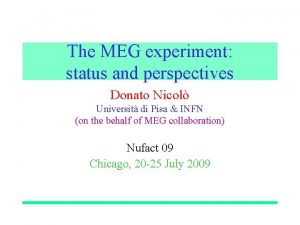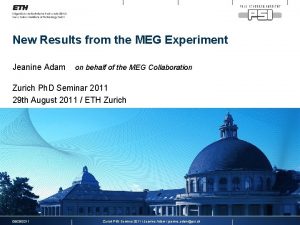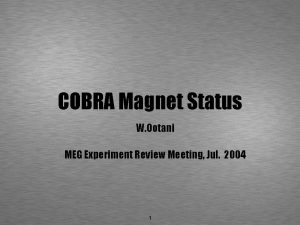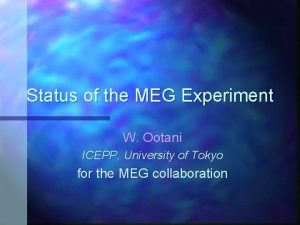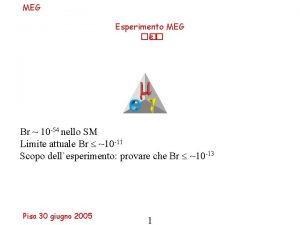Status and first Results of the MEG Experiment



















- Slides: 19

Status and first Results of the MEG Experiment Jeanine Adam on behalf of the MEG Collaboration The New, the Rare and the Beautiful 7 th January 2010 / University of Zurich 01/07/2010 Zurich 2010 / Jeanine Adam / jeanine. adam@psi. ch

Introduction MEG Detector Data Taking Ø Goal § Theory § MEG Experiment Goal § Search for the lepton flavor violating decay § The goal is to reach a sensitivity of § Measured upper limits reached by other experiments: 01/07/2010 Zurich 2010 / Jeanine Adam / jeanine. adam@psi. ch 2

Introduction MEG Detector Data Taking § Goal Ø Theory § MEG Experiment Theory § Standard Model (SM) and - Oscillation: § MEG decay induced by neutrino oscillations with an estimated branching ratio of < 10 -40 (small neutrino masses) Ø Not verifiable by experimental methods! § Supersymmetry: § Supersymmetric theories predict branching ratios of ~10 -14 – 10 -12 Ø Just below the current experimental limit (1. 2 × 10 -11)! Ø An observation of 01/07/2010 will reveal new physics beyond the SM! Zurich 2010 / Jeanine Adam / jeanine. adam@psi. ch 3

Introduction MEG Detector Data Taking § Goal Ø Theory § MEG Experiment Signature and Background § Signature of a event (decay at rest): § Emitted back-to-back § Each particle carries an energy equal to half of the muon mass (52. 8 Me. V) § Coincident in time § Background § Radiative muon decay: → e § Accidental coincidence: → e + e. g. from AIF Ø Precise measurements of position, energy and timing both for photon and positron are necessary! 01/07/2010 Zurich 2010 / Jeanine Adam / jeanine. adam@psi. ch 4

Introduction MEG Detector Data Taking § Goal § Theory Ø MEG Experiment § International collaboration of ~80 physicists § MEG is located at the Paul Scherrer Institute (PSI): § 590 Me. V proton ring cyclotron facility § 2. 2 m. A proton current § E 5 beam channel: Surface of 28 Me. V/c § Continuous 01/07/2010 beam Zurich 2010 / Jeanine Adam / jeanine. adam@psi. ch 5

Introduction MEG Detector § § § Data Taking Beam and Target Photon Detector Positron Spectrometer MEG Detector § Photon: Liquid xenon scintillation detector (position, timing, energy) § Positron: COBRA positron spectrometer (position, timing, energy) 01/07/2010 Zurich 2010 / Jeanine Adam / jeanine. adam@psi. ch 6

Introduction MEG Detector Data Taking Ø Beam and Target § Photon Detector § Positron Spectrometer Beam and Target § Beam BTS target E § E 5 beam channel § Wien filter ( / separation) § Superconducting beam transport solenoid (BTS) with degrader § Stopping rate of 3 × 10 7 /sec / Wien filter MEG detector 590 Me. V proton beam quadrupole magnets § Target § 205 m thick polyethylene foil clamped between a ROHACELL frame § Slanted angle of 20. 5° § Holes (r=5 mm) to check vertex reconstruction 01/07/2010 Zurich 2010 / Jeanine Adam / jeanine. adam@psi. ch 7

Introduction MEG Detector Data Taking § Beam and Target Ø Photon Detector § Positron Spectrometer Photon Detector § Photons are detected with the world’s largest liquid xenon detector § Filled with 900 liter of LXe (T=161 -165 K) § Scintillation light is picked up by 846 PMTs surrounding the detector § High purity at sub-ppm level to avoid scintillation light absorption due to impurities (water, oxygen) 01/07/2010 Zurich 2010 / Jeanine Adam / jeanine. adam@psi. ch 8

Introduction MEG Detector Data Taking § Beam and Target § Photon Detector Ø Positron Spectrometer § The MEG positron spectrometer consists of a specially designed superconducting magnet COBRA, a drift chamber system and timing counters § The spectrometer provide momentum, track and timing information about the positron 01/07/2010 Zurich 2010 / Jeanine Adam / jeanine. adam@psi. ch 9

Introduction MEG Detector Data Taking § Beam and Target § Photon Detector Ø Positron Spectrometer: COBRA § COBRA is composed of a superconducting main magnet and two normal conducting compensation coils: § Main magnet: Composed of 5 superconducting coils with different radii → gradient magnetic field (B = 0. 49 – 1. 27 Tesla) § Compensation Coils: Reduce magnetic field around the photon detector 01/07/2010 Zurich 2010 / Jeanine Adam / jeanine. adam@psi. ch 10

Introduction MEG Detector Data Taking § Beam and Target § Photon Detector Ø Positron Spectrometer: COBRA Advantages § Positrons emitted close to 90° § COnstant Bending RAdius 01/07/2010 Zurich 2010 / Jeanine Adam / jeanine. adam@psi. ch 11

Introduction MEG Detector Data Taking § Beam and Target § Photon Detector Ø Positron Spectrometer: Drift Chamber System § MEG drift chamber system: § 16 modules aligned radially to the beam axis § Each module consists of two wire planes shifted against each other § Low-material construction: § Cathodes consist of 12. 5 m thick Kapton foils with 250 nm aluminium deposition § Open frame construction § Operated with a He: C 2 H 6 (50: 50) gas mixture 01/07/2010 Zurich 2010 / Jeanine Adam / jeanine. adam@psi. ch 12

Introduction MEG Detector Data Taking § Beam and Target § Photon Detector Ø Positron Spectrometer: Timing Counter § The MEG timing counter consists of two scintillator timing counter arrays placed at each end of the spectrometer each with a 2 -layer construction: scintillating fibers with APDs § Phi-Counter: § Plastic scintillator bars along beam axis § Read out by PMTs at both sides § Positron timing measurement § Z-Counter: § Scintillation fibers § Read out by APDs § Additional trigger information scintillation bars with PMTs 01/07/2010 Zurich 2010 / Jeanine Adam / jeanine. adam@psi. ch 13

Introduction MEG Detector Data Taking Ø Run 2008 § Results 2008 § Run 2009 Data Taking § Commissioning run 2007: § All detector components assembled § Calibrations, trigger tuning § Test physics run (1 – 2 days) § Run 2008: § Shutdown period: § May – Aug 2008: § Sep – Dec 2008: Solve problems appeared during 2007 Calibrations Physics data taking ( ~ 3 months) § Remark: § PSI accelerator shutdown from Christmas to mid of April → no beam! § Another experiment is located in the E 5 area → beam time is split 01/07/2010 Zurich 2010 / Jeanine Adam / jeanine. adam@psi. ch 14

Introduction MEG Detector Data Taking § Run 2008 Ø Results 2008 § Run 2009 MEG Detector Resolutions in 2008 § Positron Energy: § Resolution function: triple Gaussian (core + 2 tail components) § Core: 374 ke. V (60%) Tails: 1. 06 Me. V (33%) / 2. 00 Me. V (7%) § Photon Energy: § Asymmetric with low-energy tail § E/E = (5. 8 ± 0. 35) % FWHM with a right tail of R = (2. 0 ± 0. 15) % § Positron – Photon Timing: § te = (152 ± 16) ps § Positron – Photon Angles: § e ~ 21 mrad § e ~ 14 mrad 01/07/2010 Zurich 2010 / Jeanine Adam / jeanine. adam@psi. ch 15

Introduction MEG Detector Data Taking § Run 2008 Ø Results 2008 § Run 2009 Blind Box & Likelihood Analysis § Pre-Selection Box: § Data reduction for analysis § Blind Box: § Written to separate data-stream § Not used to study background and optimize analysis § Analysis Box: § Maximum likelihood analysis based on Feldmann – Cousins approach E [Me. V] Pre-Selection Box Blind Box Analysis Box 60 58 56 54 52 50 48 46 44 42 40 16 18 20 22 24 26 28 30 32 34 36 25 20 15 10 5 0 T - Te [nsec] Ø The preliminary result from the first 3 months startup period of MEG 2008: Source: 01/07/2010 ar. Xiv: 0908. 2594 v 1 [hep-ex] “A limit for the Zurich 2010 / Jeanine Adam / jeanine. adam@psi. ch decay from the MEG experiment” 16

Introduction MEG Detector Data Taking § Run 2008 § Results 2008 Ø Run 2009 § Jan – Aug 2009: Hardware improvements § New printed circuit board (PCB) for the drift chambers → DC high voltage problem solved § Improvement of the LXe purification system → higher light yield § Installation of DRS 4 chip → ghost pulse problem solved, no/reduced temp. dep. § September 2009: Detector assembling § October 2009: Calibrations § Nov – Dec 2009: Physics data taking ( ~ 2 months) Ø Run 2009 stopped at 22 December 2009 01/07/2010 Zurich 2010 / Jeanine Adam / jeanine. adam@psi. ch 17

Introduction MEG Detector Data Taking § Run 2008 § Results 2008 Ø Run 2009 Results 2009 § The preliminary result from MEG run 2009: coming soon. . . 01/07/2010 Zurich 2010 / Jeanine Adam / jeanine. adam@psi. ch 18

Introduction MEG Detector Data Taking Summary and Prospects § The MEG experiment is searching for the LFV decay aiming a sensitivity of ~10 -13 § Physics data production started in Sep 2008 (physics runs in 2008/2009) § Data taken during the first startup period (3 months) of the MEG experiment in 2008 yielded an upper limit on the branching ratio of § MEG time schedule: § Hardware improvements (Jan – April 2010) § Assembling of all detector components / calibrations (May 2010) § Take physics data (June – Dec 2010, 2011) Ø MEG is expected to reach a sensitivity of ~10 -13 in a few years 01/07/2010 Zurich 2010 / Jeanine Adam / jeanine. adam@psi. ch 19
 Melting different types of chocolate experiment
Melting different types of chocolate experiment Hypothesis of paper airplanes
Hypothesis of paper airplanes Electron diffraction experiment results
Electron diffraction experiment results Asch conformity experiment results
Asch conformity experiment results The results of dr.frank's experiment
The results of dr.frank's experiment Results first clearinghouse database
Results first clearinghouse database Meg hourihan
Meg hourihan Meg whitman house
Meg whitman house Meg stone etsu
Meg stone etsu Elektronok száma
Elektronok száma Slidetodoc.com
Slidetodoc.com 50 meters compared to human
50 meters compared to human Klór elektronszerkezete
Klór elektronszerkezete Száma az atom minőségét szabja meg
Száma az atom minőségét szabja meg Körív hossza
Körív hossza Meg
Meg Meg malone
Meg malone Zsebtelep
Zsebtelep Kort presentasjon av meg selv eksempel
Kort presentasjon av meg selv eksempel Flipped classroom moodle
Flipped classroom moodle


